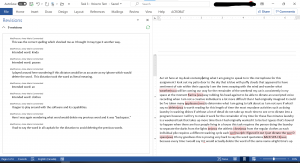
Screen capture of speech to text exercise.

Speech to text dictation with comments added.
Task 3 – My notes with guiding questions
How does the text deviate from conventions of written English?
When reading Gnanadesikan’s (2011) thoughts about writing, they noted that “[w]riting is one of the most important human inventions of all time” (p.2). Although these are the written words, through dictation, my specific text deviates from the conventions of writing, as many grammatical errors are present. Thus, even though it is recorded and by all accounts according to Gnanadesikan (2011) should be considered reliable. Someone reading this could not make sense of my thoughts, as this piece of “reliable transmission” (Gnanadesikan, 2011, p. 3) does not have many of structures of writing that would convey more meaningful message.
As I have had previous experience with such tools, not just my iPhone, I had an understanding there would be many mistakes when it came to how I would dictate my words. For example, I had to refrain from adding the appropriate punctuation when dictating. Therefore, I am not surprised by such software.
What is “wrong” in the text? What is “right”?
Wrong:
The text is one long sentence. This text is not scripted and does not contain any coherent and logical thought process. Only towards the end, can the reader follow a more coherent thought process as I have attempted to play with the software and learn what word will delete text I did not want.
Right:
According to Haas (2013), this text should still be considered part of language as it is material which is “having mass or matter and occupying a physical space” (p.4) and that the tools of writing “have mass, as do written products” (p.4). This is contrast to Gnanadesikan’s (2011) thoughts, who states it could be ‘lost in translation’ as the story is passed around from one person to another via speech, where the memory of a human is not as reliable. What this software did do correctly was recognize my pronunciation of conjunctions. The dictation did capitalize all my pronouns “I” without stating, “capital I.”
From my personal experience with dictations software in previous years, this was not always the case, and I am happy to see AI in this software has improved.
What are the most common “mistakes” in the text, and why do you consider them “mistakes”?
The dictation did not capitalize any of the words until I told it to. The AI of this software was unable to recognize proper nouns. I consider the lack of capitalization a mistake, as it will not tell the reader if it is a proper noun or pronoun.
Therefore, without proper grammar or punctuation, one cannot recognize nuances such as “intonation and emotional” (Gnanadesikan, 2011, p. 9), which, if I were speaking, could have presented the listener with a very different story.
What if you had “scripted” the story? What difference might that have made?
If I had a scripted story, I would have been able to avoid the long pauses between my thoughts which would not have led to such a random assortment of thoughts dictated into the software. Gnanadesikan (2011) has said that “[w]riting is generally done more deliberately than speaking, so finished written pieces are much more carefully crafted than a typical spoken sentence” (p.5).
Therefore, if I had a scripted story, would I have been more mindful of my speech and pronunciation, making more effort to pronounce all letters more clearly? However, if I had a script, would I have spoken much faster, which could have hindered the pronunciation of my words and may have led to even more mistakes? These are questions I have when writing this piece.
In what ways does oral storytelling differ from written storytelling?
Oral storytelling can differ vastly from written language. As noted by Gnanadesikan (2011), “the message would be very different by the end” (p.3) as each individual may interpret words or sounds differently. A similar scenario was presented by Lera Boroditsky (2017) in her talk “How the languages we speak shape the way we think.” She explained that there might not be a direct translation from one language to another, thus requiring an intermediary to bridge the gap between the two languages. Therefore, if an oral story was being told to a different language group that may not have similar nuances, would the same meaning be conveyed in the retelling? In addition, oral storytelling is only as good as the individual who tells the story. Their memory may fade, or the words are immediately gone when escaping the original storyteller (Haas, 2013).
References
Boroditsky, L. (June 2017). [Video]. How the languages we speak shape the way we think.
Gnanadesikan, A. E. (2011).“The First IT Revolution.” In The writing revolution: Cuneiform to the internet. (Vol. 25). John Wiley & Sons (pp. 1-10).
Haas, C. (2013). “The Technology Question.” In Writing technology: Studies on the materiality of literacy. Routledge. (pp. 3-23).